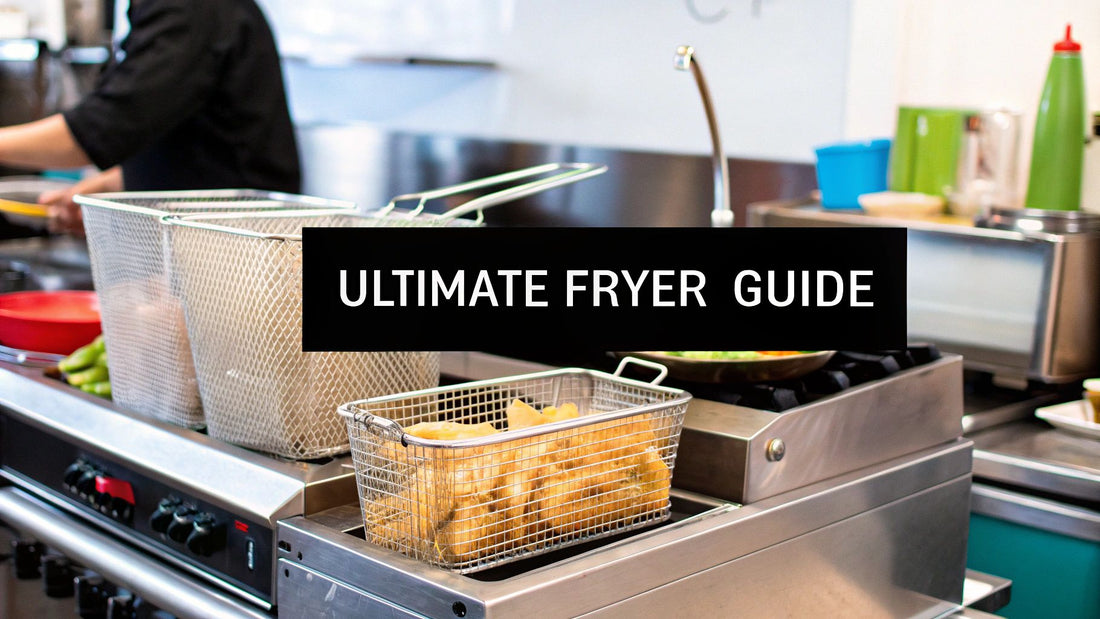
Atosa Fryer ATFS-40 The Ultimate Kitchen Guide
Share
The Atosa ATFS-40 is a serious piece of commercial kitchen equipment, essential for chefs and restaurant owners focused on performance. It's a heavy-duty gas fryer that has earned a reputation for being durable, efficient, and a solid value for the money. Built for kitchens that crank out a lot of food, it boasts a 40-pound oil capacity and a tough stainless steel build, making it a true workhorse when you need perfectly crispy food, rush after rush. Stay informed about the latest industry trends and find exclusive deals on equipment like this to keep your kitchen at the cutting edge.
Why the Atosa ATFS-40 is a Kitchen Staple
If you've ever worked in a high-pressure restaurant kitchen, you know the equipment has to be built like a tank. A fryer isn't just another appliance; for many spots, it's the heart of the line, pumping out everything from golden fries and crispy chicken to all those appetizers that keep customers happy. This is exactly where the Atosa ATFS-40 proves its worth, becoming less of a machine and more of a reliable partner in the kitchen.
For any chef or owner, picking a fryer is a big deal. It directly affects how your food turns out, how quickly orders get to the window, and how much you spend on utilities and oil. The ATFS-40 was clearly designed with these real-world pressures in mind. It’s built to deliver where it counts, not just to look good on a spec sheet. Discovering the right equipment at the right price is key to success.
Built for the Grind of a Professional Kitchen
The real measure of any piece of kitchen gear is how it holds up during a chaotic dinner service. The Atosa ATFS-40 is constructed with a rugged, all-stainless-steel body, so it can take the daily abuse of a fast-paced environment. That durability means it's going to last, giving you a much better return on your investment over the years.
This isn't just any fryer; it's a heavy-duty commercial unit designed for constant, demanding use. One of its most significant advantages is its ability to hold up to 40 pounds of oil. That's a huge step up from many other models in its class, which often top out around 15 to 30 pounds. More oil capacity means your crew can cook larger batches at once, which is a straight line to higher output and faster service.
The true value of a fryer like the ATFS-40 is its consistency. It’s designed to hold its temperature precisely, ensuring the last batch of fries served at closing is just as crisp and golden as the first one out of the basket at lunch.
More Than Just a Fryer—It's an Operational Asset
When you start thinking of the ATFS-40 as a strategic part of your operation, its value becomes even clearer. Its smart engineering helps your team deliver consistent results, which is the secret sauce for keeping customers happy and coming back. It becomes the reliable anchor of your fry station, giving you the confidence to execute your menu without a hitch.
Getting your kitchen set up right is everything, and a powerful, dependable fryer is a non-negotiable item on any good commercial kitchen equipment checklist. For professionals focused on efficiency and quality, the ATFS-40 is a trusted choice that helps drive success.
Turning Specs Into Real-World Kitchen Performance
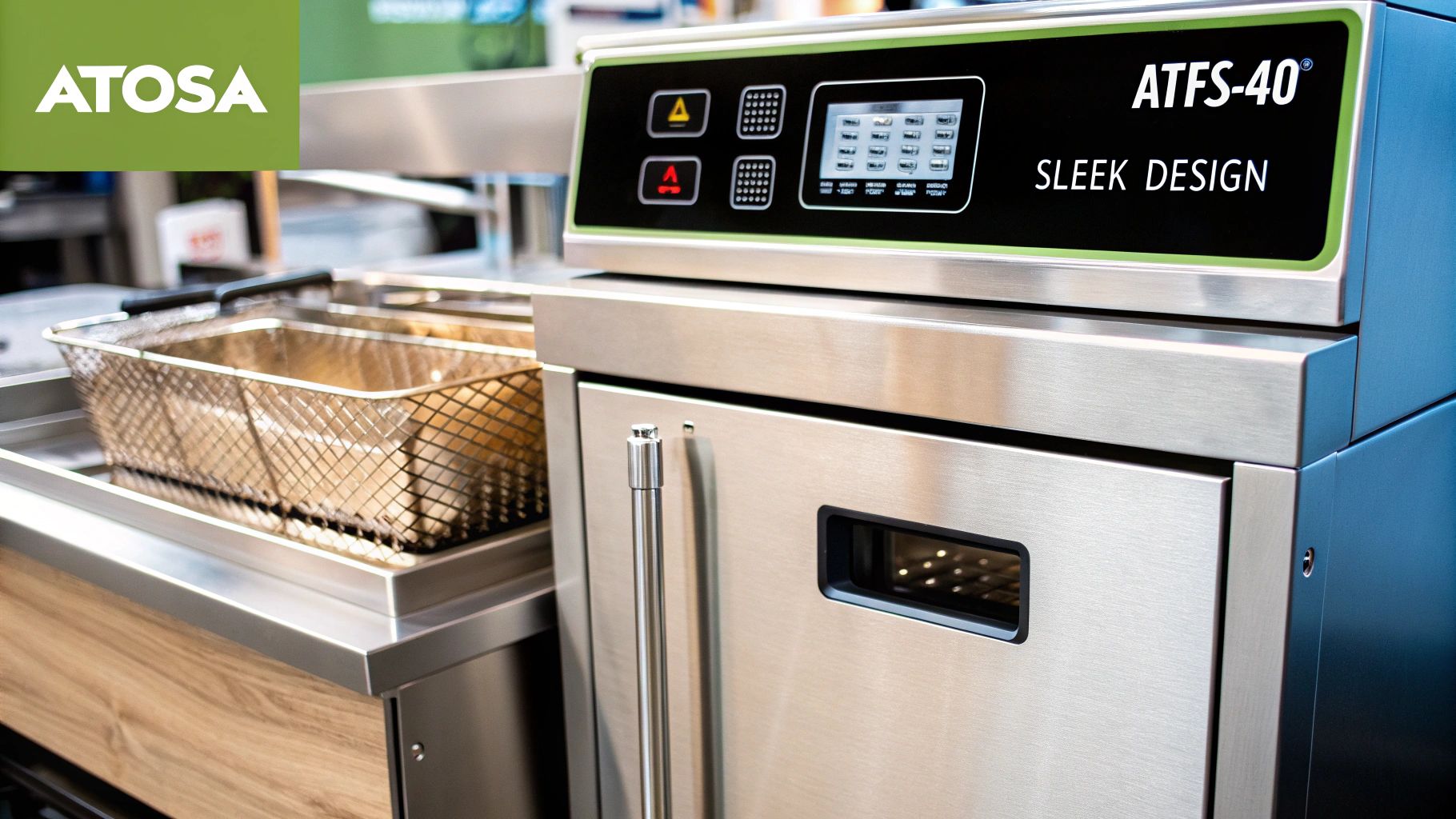
Let's be honest, spec sheets can be a bit dry. Numbers and technical terms don't always paint a clear picture of how a piece of equipment will actually perform during a chaotic Friday night rush. So, let's translate the key specs of the Atosa ATFS-40 into what they really mean for your food, your staff, and your profits.
Think of this fryer's 102,000 BTU rating as the horsepower in an engine. It's all about raw power and, more importantly, quick recovery.
Every time your cook drops a basket of frozen fries into hot oil, the temperature plummets. A wimpy fryer struggles to get back up to temp, leaving you with greasy, under-cooked food that kills ticket times. The ATFS-40, with its massive BTU output, snaps back to the perfect frying temperature almost instantly. That’s how you get that consistently crispy, golden-brown finish on every single order, even when you're slammed.
A Deeper Dive Into The Numbers
To give you a clearer snapshot, here’s how the core specifications of the Atosa ATFS-40 fryer directly benefit a busy kitchen environment.
Atosa Fryer ATFS-40 Key Performance Specifications
| Specification | Measurement | Practical Benefit for Your Kitchen |
|---|---|---|
| Total BTU | 102,000 BTU/hr | Faster heat-up and recovery. This means less downtime between batches, leading to quicker ticket times and consistently crispy food, even during peak hours. |
| Oil Capacity | 40 lbs | Higher production volume. Allows for cooking larger batches without overcrowding the fry pot, increasing your kitchen's overall output and serving capacity. |
| Burners | 3 High-Efficiency Cast Iron | Even heat distribution. Eliminates "hot spots" in the oil, ensuring every piece of food cooks uniformly for better quality and less waste. |
| Construction | Stainless Steel Tank & Cabinet | Built to last. Resists corrosion, dents, and grime from the daily grind of a commercial kitchen. It's also much easier to clean and maintain. |
| Controls | Millivolt Thermostat (200°F - 400°F) | Precise and reliable temperature control. No electricity required for the thermostat, offering simplicity and dependability. Your team can easily dial in the perfect temp for any food. |
| Cool Zone | Sediment Trap in Tank Bottom | Saves you money on oil. Collects food particles below the burners, preventing them from burning and spoiling the oil. This significantly extends oil life, cutting down on a major operational cost. |
Seeing the specs laid out like this makes it clear that every feature is designed with a purpose—to make your kitchen more efficient, your food more consistent, and your operation more profitable.
Capacity And Build Quality In Action
The 40-pound oil capacity isn’t just a number; it’s about workflow. It gives your team the room to cook bigger batches without the food sticking together, which is a lifesaver when you have a full order board. You're simply able to push out more food, faster.
And that full stainless steel body? That’s your insurance policy. Kitchens are tough environments—things get spilled, bumped, and covered in grease. The heavy-duty construction of the Atosa fryer means it can take the abuse and still clean up nicely at the end of the night.
One of the smartest, yet most overlooked, features is the oil cooling zone. It's a simple design trick at the bottom of the tank that saves restaurant owners a small fortune by making their cooking oil last longer.
Here’s how it works: crumbs and bits of batter naturally fall off the food as it cooks. Instead of sitting in the hot oil and burning, they sink down into this cooler area below the burners. By keeping that sediment from scorching and contaminating the rest of the oil, the fryer keeps your oil cleaner for way longer. This means fewer expensive oil changes and a real, measurable drop in your operating costs.
When you understand how these features work together, you see the Atosa fryer ATFS-40 for what it is—not just another fryer, but a workhorse designed for performance, durability, and a smarter bottom line.
Your Guide to a Flawless First-Time Setup
An Atosa ATFS-40 is a serious piece of kitchen equipment. And like any high-performance tool, getting the most out of it starts with a rock-solid setup. Nailing the installation isn't just about plugging it in—it's about creating the right environment for your new workhorse to ensure safety, deliver consistent results, and last for years.
Before the delivery truck even pulls up, there are a couple of things you absolutely have to sort out. The big ones are your gas connection and ventilation. The ATFS-40 has specific gas requirements, and this connection must be handled by a certified professional. Seriously, this is not a DIY job. Fumbling this can lead to dangerous leaks and will instantly void your warranty.
Just as critical is your kitchen's ventilation. A commercial fryer kicks out a ton of heat and grease-filled vapor. You need a powerful hood system that meets all your local fire and safety codes, no exceptions. It’s essential for keeping your air clean and your kitchen safe.
The Initial Setup Checklist
Once your space is prepped and ready, the actual installation is pretty straightforward, but the details matter. Follow these steps to get your Atosa fryer ATFS-40 humming.
- Find the Right Spot: Place the fryer directly under your commercial ventilation hood. Make sure you leave enough clearance from any walls or flammable materials, just as your local codes require.
- Level the Unit: Grab a spirit level and make sure the fryer is perfectly flat. If it’s tilted, your oil will pool to one side, leading to food that’s burnt on one end and undercooked on the other. Tweak the adjustable legs until that bubble is dead center.
- Connect the Gas: This is where your certified tech comes in. They'll hook up the gas line, making sure it's secure and supplying the right pressure for the burners to work their magic.
This image breaks down the basic workflow for the Atosa ATFS-40 once it's all set up and ready to go.
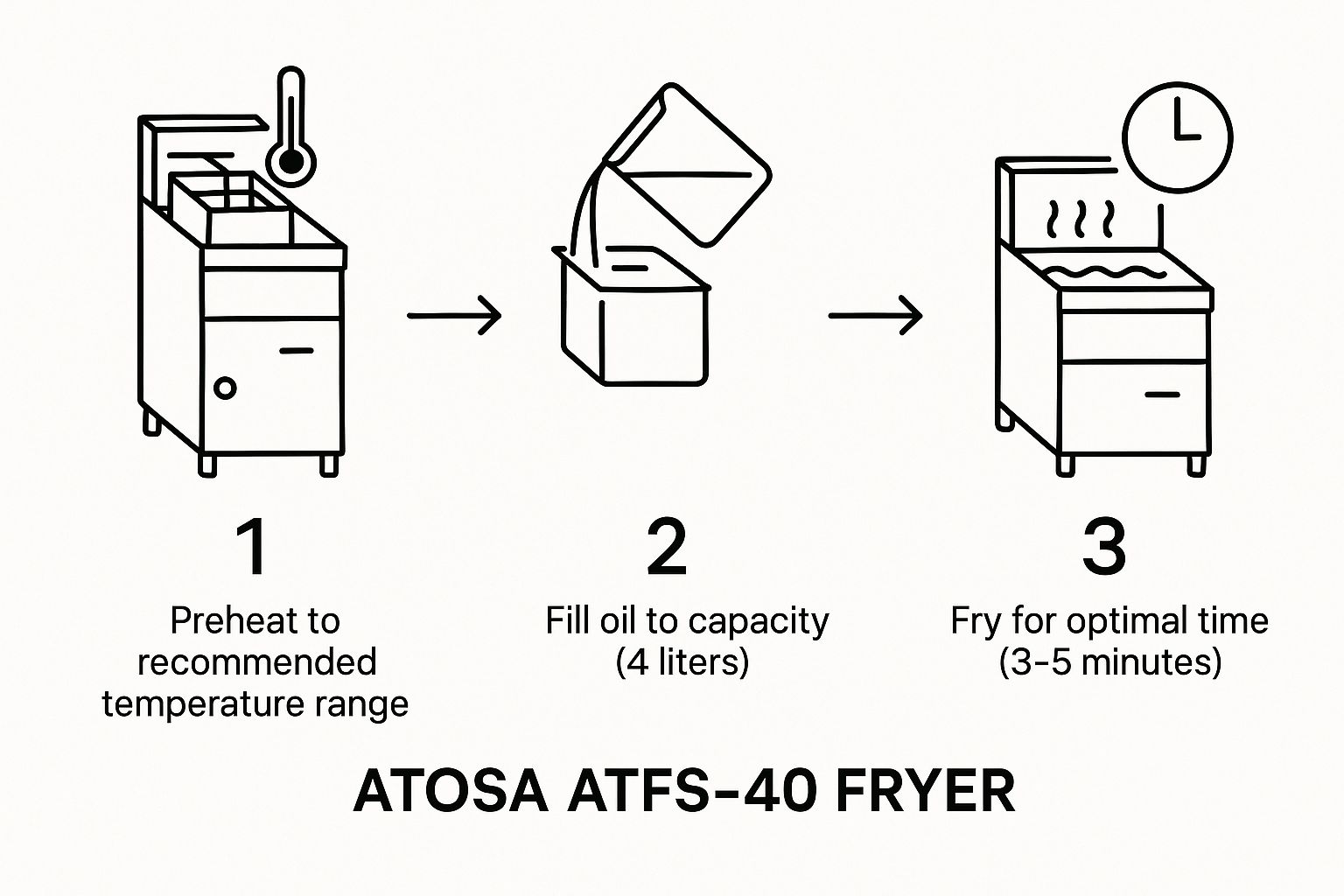
It’s a simple visual guide, but it highlights the key things you need to manage—temperature, oil level, and timing—to get that perfect golden-brown finish every time.
The Critical First Boil Out
Don’t even think about dropping a basket of fries in there yet. Before its first real use, you have to do an initial "boil out." Think of it as a deep clean to get rid of any machine oils, dust, or other residues left over from the factory. If you skip this, your first few batches of food might have a weird metallic taste.
A proper boil out isn't just cleaning; it's seasoning. This initial step prepares the stainless steel tank, ensuring pure flavor and optimal performance from the very first use.
To do it, you’ll fill the tank with water and a special fryer cleaning solution. Bring it to a gentle boil for about 20 minutes, then carefully drain it and rinse the tank out completely. It's a one-time chore, but it's your ticket to clean, delicious fried food from the moment you turn it on.
Mastering Daily Operations for Perfect Results
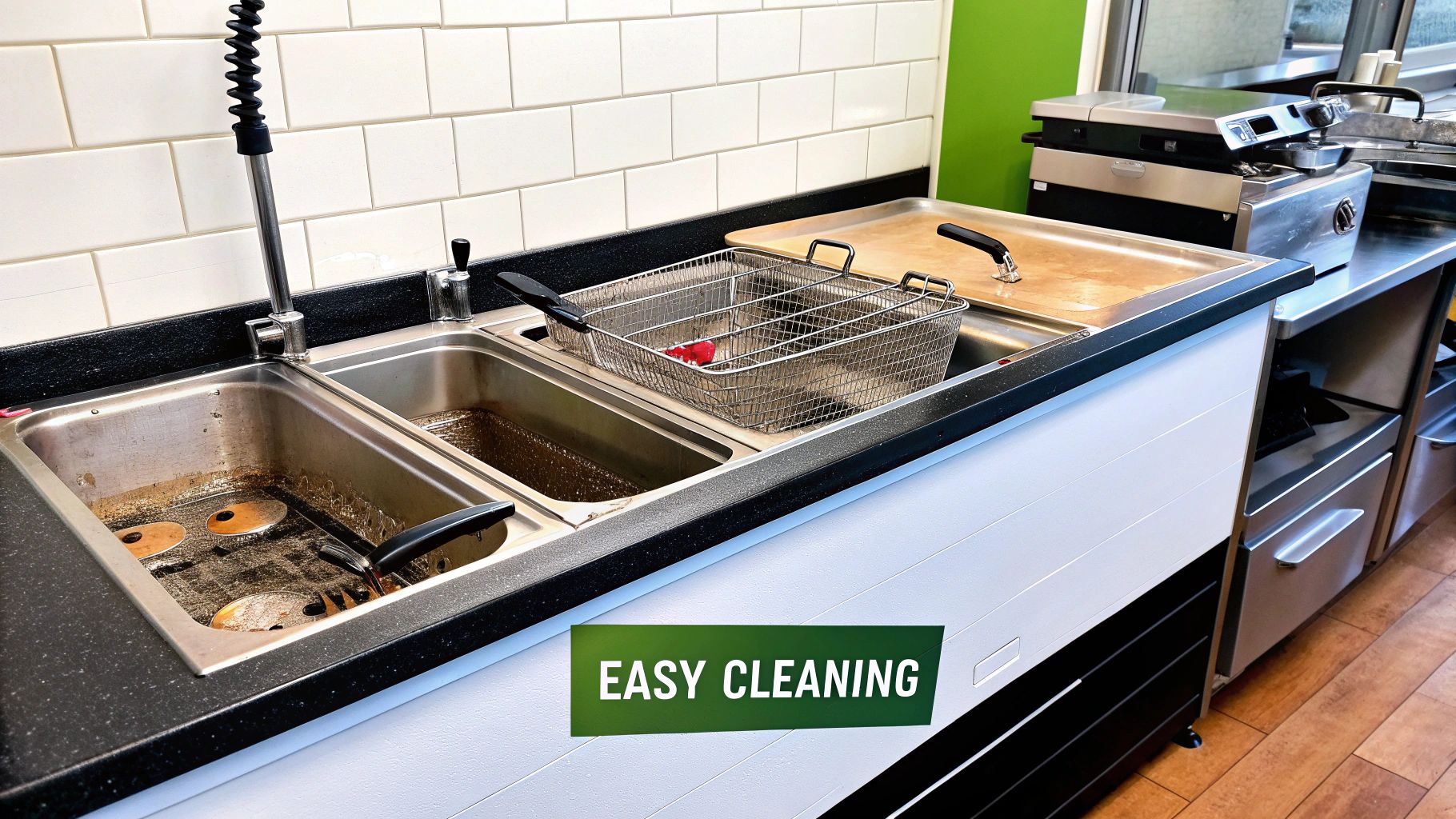
Running an Atosa fryer ATFS-40 is more than just flipping a switch. It's a craft, and how you use it every day directly impacts the quality of your food and, ultimately, your bottom line. When you get the daily routine down pat, this reliable workhorse becomes a true high-performance machine, churning out perfectly crispy food, shift after shift. And it all starts long before that first ticket comes in.
Think of proper preheating as the foundation for everything you fry. It's so tempting to rush this step during a busy prep, but that's a classic mistake that leads to soggy, greasy food nobody wants. You have to give the oil time to get up to temperature—usually somewhere between 350°F and 375°F for most foods. Just as important, let it sit there for a good 10-15 minutes before you drop that first basket. This ensures the powerful burners have fully heated the oil, creating a solid thermal base that won't crash when cold food hits it.
Managing Temperature Like a Pro
Once service hits full swing, your fryer's temperature is going to bounce around as baskets go in and out. That's just a fact of life in a busy kitchen. The real skill is in managing that thermal rollercoaster. The ATFS-40 has a serious 102,000 BTU output, which means it recovers heat fast, but a few smart habits can make it even better.
- Don't Overload the Baskets: This is the number one fryer foul. Jamming a basket full of frozen fries will cause a massive temperature drop, guaranteed. It's always better to cook slightly smaller batches more often than it is to shock the oil with a huge, cold load.
- Shake Off That Ice: For any frozen products, give the basket a good, hard shake to knock off all the loose ice crystals before it goes in the oil. This simple move lessens the initial temperature shock and cuts down on dangerous splattering.
- Use Both Baskets Smartly: If you're running both baskets, stagger your drops. Cook in one while the other side recovers. This little bit of timing helps keep the overall oil temperature far more stable.
Oil Quality: The Secret Ingredient
Don't forget, your cooking oil is an ingredient—just as important as your potatoes or chicken. Taking care of it is a non-negotiable part of running a professional kitchen. A strict schedule for filtering and changing your oil doesn't just save a surprising amount of money; it's the only way to make sure your food tastes clean, crisp, and delicious.
The best chefs will tell you that the health of their oil is everything. When oil starts to break down, it smokes at lower temps, gets dark way too fast, and makes food taste bitter and funky. Learning to see the signs early is a skill every cook needs.
Keep an eye out for these tell-tale signs that your oil is on its last legs:
- Darkening Color: Good oil is golden and clear. Old oil gets dark, murky, and cloudy.
- Smoking Too Soon: If you see smoke before the fryer even gets up to temp, that oil is breaking down.
- Foaming Up: A layer of foam or excessive bubbling on the surface is a dead giveaway that it's time for a change.
By making these practices part of your team's daily routine, you'll get the absolute best performance out of your Atosa fryer ATFS-40. More importantly, you'll ensure every single plate that goes out to a customer is something you can be proud of.
Essential Cleaning and Maintenance Routines
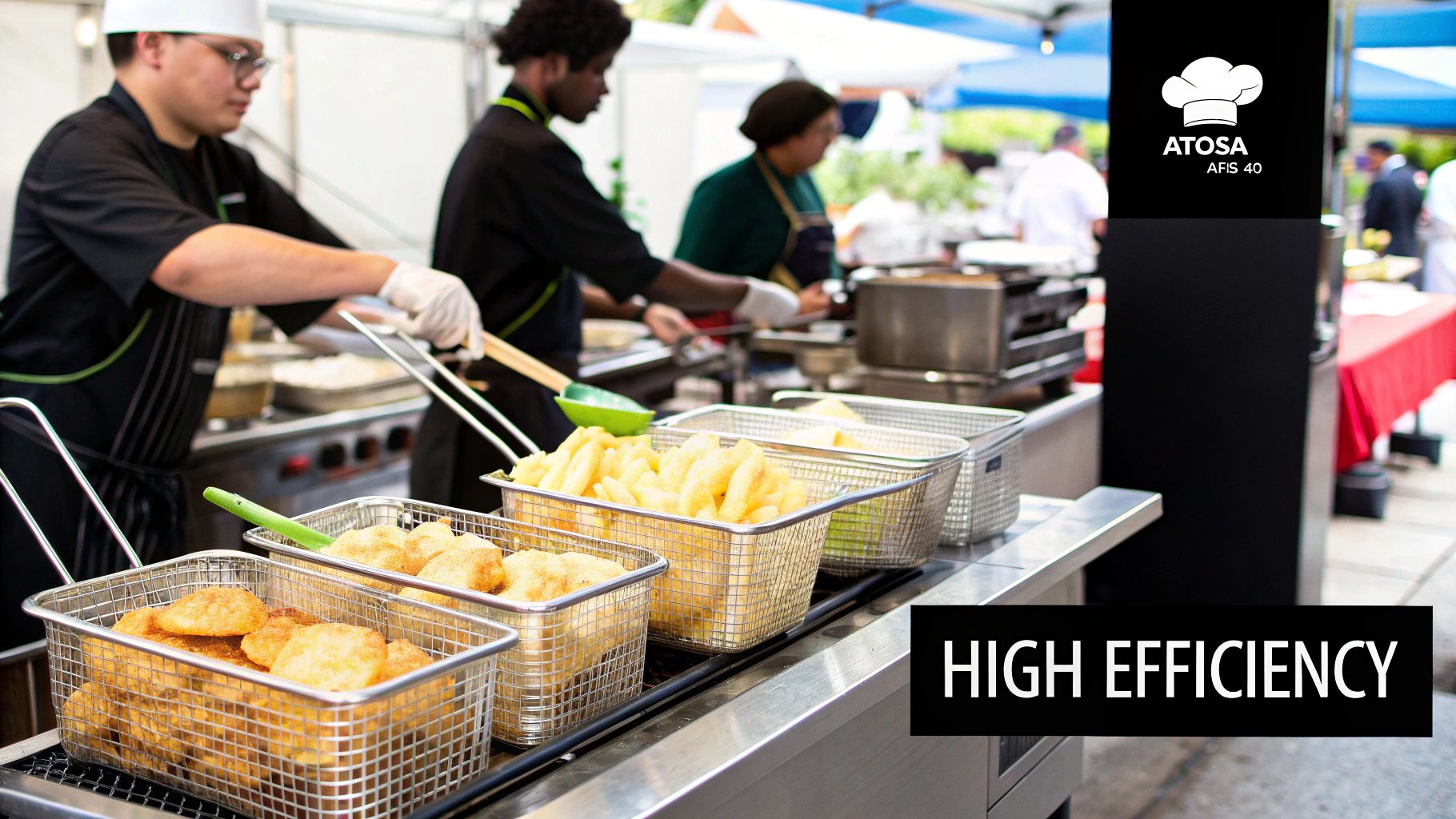
In a professional kitchen, your equipment is an investment. Plain and simple. Protecting that investment isn't just a good idea—it's non-negotiable. A well-maintained Atosa fryer ATFS-40 will not only last you for years, but it's also going to turn out consistently better-tasting food. The secret? A simple, consistent cleaning and maintenance routine that prevents costly downtime and keeps your food safe.
Think of it as preventative care for one of your kitchen's biggest workhorses. This doesn't have to be a complicated, hours-long ordeal. By breaking down the process into easy daily, weekly, and monthly tasks, you can get your whole team on board and keep that fryer running like new.
Your Daily Cleaning Checklist
These are the quick jobs that should happen at the end of every single shift. They're your first line of defense against grease buildup and flavor contamination, and they only take a few minutes. Trust me, it makes a huge difference.
- Wipe Down the Exterior: Grab a soft cloth and a good, mild degreaser. Wipe down all the stainless steel surfaces—the front, sides, and that backsplash. This simple step stops grease from baking on and becoming a nightmare to clean later.
- Clean the Fry Baskets: Give the fry baskets a thorough scrub to get rid of any caked-on food bits.
- Skim the Oil: Before you shut everything down, use a skimmer to fish out any large pieces of debris floating in the oil. This one little action seriously helps extend the life of your cooking oil.
For a more comprehensive approach to kitchen hygiene, especially around high-use equipment like this, many kitchens rely on professional restaurant cleaning services. They can handle the really deep cleaning that keeps your entire operation sparkling and up to code.
Weekly and Monthly Deep Cleaning
While those daily wipe-downs are critical, your Atosa fryer ATFS-40 needs some more intensive care to stay in prime condition. These deeper cleaning tasks are designed to tackle the tough, baked-on grime that a quick daily clean just can't touch.
If you do one thing for your fryer, make it a regular "boil out." It is the single most effective maintenance task you can perform. This is just the process of deep cleaning the fry pot to strip away all that carbonized grease. It doesn't just make your food taste clean; it actually improves the fryer's heating efficiency.
For a busy kitchen, a weekly boil out is the gold standard. To do it, you'll first need to carefully drain the old oil. Then, fill the tank with water and a specialized fryer cleaning solution, and bring it to a slow, gentle boil for about 20-30 minutes. This process is fantastic at dissolving all that stubborn, built-up gunk. After boiling, drain the cleaning solution, rinse the tank out really well, and make sure it's completely dry before you refill it with fresh oil.
Once a month, set aside some time to inspect the key components. Look at the burners for any blockages and double-check that the thermostat is calibrated correctly. Catching these little issues during a monthly check can save you from a major breakdown down the road. And just as you care for your fryer, keeping your cold storage in top shape is also vital; you can learn more about maintaining an https://encoreseattle.com/blogs/seattle-restaurant-equipment/atosa-freezer to keep all your equipment running smoothly.
Understanding Key Safety Features and Certifications
In a busy commercial kitchen, safety can't be an afterthought. It’s the bedrock that protects your crew, your guests, and the business itself. The Atosa ATFS-40 was clearly designed with this in mind, packing in essential protections and official certifications that let you cook with confidence and stay prepared for any inspection.
These features aren't just bullet points on a sales page; they are your silent partners in safety. A great example is the fryer's high-temperature safety limit. Think of it as an emergency brake for your oil. If the temperature ever spikes into a dangerous zone, this feature automatically cuts the gas, stopping a potential fire before it even has a chance to start. That, combined with a rock-solid gas control valve, keeps things stable and secure even when the dinner rush is in full swing.
Decoding Certifications and Compliance
Beyond its internal safeguards, the Atosa ATFS-40 fryer also comes with some important third-party stamps of approval. These certifications aren't just for show—they're proof that the unit has been put through its paces and passed rigorous tests for industry-wide safety standards.
When it comes to compliance, this fryer checks all the right boxes. It's ETL listed, which means an independent lab has tested and certified that it meets both U.S. and Canadian safety requirements. It's a big deal. For a deeper dive into its credentials, you can check out the official Atosa ATFS-40 fryer specifications.
That ETL mark is your guarantee that the fryer is built from the ground up to prevent hazards. It’s one of the first things a health inspector will look for and tells them you’ve invested in professional, compliant equipment.
While the ATFS-40 has its own fantastic safety systems, they're just one part of the bigger picture. You still need to manage your kitchen's overall safety. Using a detailed commercial fire safety inspection checklist is a smart way to keep your entire operation up to code, from the ventilation hoods right down to the fire suppression systems. Getting a handle on these certifications confirms you've chosen a fryer that's ready for a regulated, professional environment.
Got Questions About the Atosa Fryer ATFS-40? We’ve Got Answers.
When you're about to bring a new workhorse like the Atosa ATFS-40 into your kitchen, you’re bound to have some questions. It’s a big decision, and getting the right answers ensures this fryer will be a perfect fit for the way you work.
We've gathered the most common questions from chefs and owners right here to give you quick, straightforward answers so you can make a smart choice and discover the latest deals on top-tier equipment.
Operational and Technical Details
One of the first things everyone asks is about the gas hookup. Straight out of the box, the ATFS-40 is set up for natural gas (NG), which is what most commercial kitchens run on. But if you're using propane, don't worry—a liquid propane (LP) conversion kit is included. Just make sure you have a certified technician handle the installation.
People also want to know what's included. Atosa gets you started with everything you need right away:
- Two Nickel-Plated Fry Baskets: These are your go-to tools for juggling different orders or keeping items separate.
- A Crumb Rack: Sits just above the cool zone to catch bigger pieces of batter and food, which is a huge help in keeping your oil clean.
- A Drain Extension: A simple but brilliant little tool that makes draining used oil way less of a messy chore.
We get a lot of questions about the "cool zone," and for good reason—it's a real money-saver. This area at the bottom of the fry pot stays cooler than the rest of the oil, so crumbs and sediment fall into it without burning. This small design feature makes a huge difference in how long your oil lasts, saving you a ton of cash over time.
Knowing how all these pieces work together helps you get the most out of your fryer. And if you ever need a replacement basket or want to upgrade a component, you can find exactly what you're looking for in our guide to Atosa fryer parts.
Safety and Compliance Information
Of course, safety is always a top concern. You can rest easy knowing the Atosa ATFS-40 is fully ETL and ETL Sanitation certified.
This isn't just a sticker; it's a guarantee from an independent lab that the fryer has passed tough tests for North American safety and sanitation standards. It means you'll fly through health inspections and can run your kitchen with confidence.
Ready to put the reliable power of the Atosa ATFS-40 to work in your kitchen? Encore Seattle Restaurant Equipment has great prices and the expertise to help you get the right gear for your restaurant. Stay informed on the latest industry trends and find exclusive deals by connecting with us.
